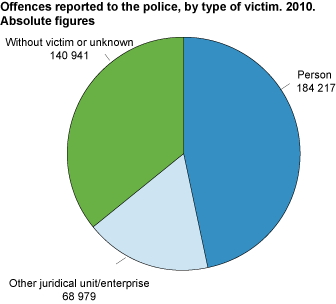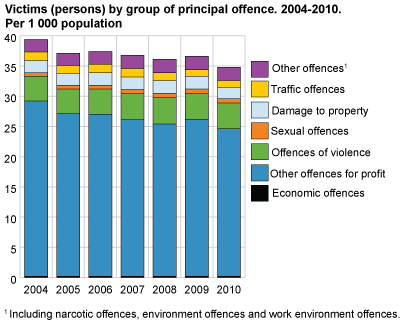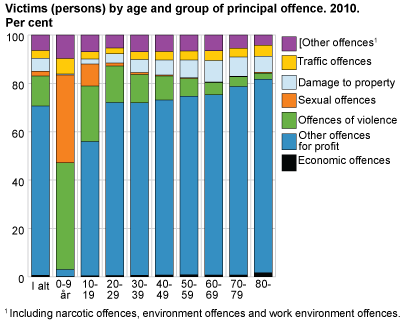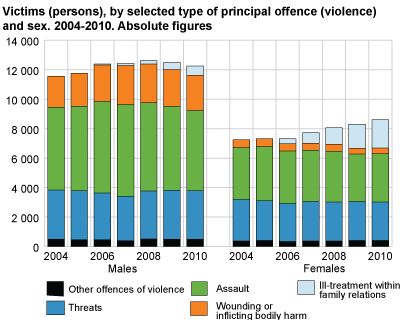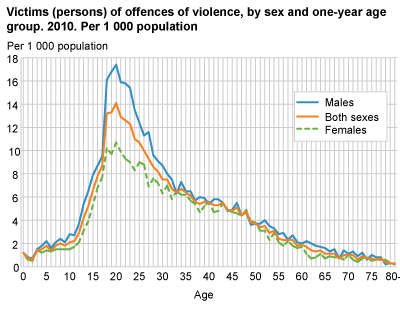Content
Published:
This is an archived release.
Fewer victims of theft, more female victims of violence
Of the total population of Norway, 3.4 per cent were registered as victims of offences in 2010. A total of 169 000 persons were registered as victims, which is 3.9 per cent fewer than the previous year. In recent years, the number of registered victims of violence has been stable, but there are fewer young victims and more female victims of violence.
Of the 394 000 offences reported to the police in 2010, nearly half (46.7 per cent) were registered with a person as a victim, and 17.5 per cent were registered as committed against enterprises or other juridical units. The total number of offences against persons and enterprises decreased from 2009, by 4.1 and 5.8 per cent respectively.
Nearly 127 000 offences for profit were committed against persons and 43 500 against enterprises; 5.4 and 8 per cent fewer than the relatively high numbers of offences reported to the police in 2009. Also reported were 10 400 cases of damage caused to private property and 9 900 to property owned by enterprises; a decline of 10 and 16 per cent respectively.
Of all offences reported to the police in 2010, 35.8 per cent were without a registered victim (see figure). Narcotic and traffic offences make up about two thirds of all offences without registered victims.
Fewer victims of offences for profit
In total, nearly 120 000 persons were registered as victims of offences for profit in 2010 - a reduction of nearly 6 600 from the previous year. Theft and other offences for profit is the principal group of offence for 70 per cent of all persons registered as victims. The reduction of offences for profit contributes to an overall reduction of the number of persons registered as victims in Norway. The number of persons registered as victims is lower than the previous six years (see figure). A total of 41 100 persons were registered as victims of simple and aggravated larcenies from houses, holiday houses or motor vehicles - almost 4 800 fewer than in 2009.
In 2010, 4.5 per cent of the population of Oslo were registered as victims of offences for profit, and these make up more than a fifth of registered victims of this type of offence in Norway. The corresponding proportion in Sogn og Fjordane; the county with the highest decline in percentages and the lowest proportion of victims of offences for profit, is 1.1 per cent.
Young people most at risk of offences
Young adults have the highest risk of being registered as victims of offences. A total of 6.6 per cent of the population of Norway in the age group 20-29 were registered as victims in 2010, whilst the corresponding proportion for the age group 70-79 was 1.6 per cent.
but different age groups are victims of different types of offences
Looking at separate age groups and distribution by principal group of offence, we find some relatively clear patterns: 80 per cent of victims in the age group 0-9 years have been exposed to sexual or violent offences. The corresponding proportion of victims in the age group 20-29 and 70-79 years is 16 and 4 per cent respectively. An approximately opposite pattern can be found relative to other offences for profit, among others, which is the principal group of offence for 80 per cent of the victims aged 80 years or older - and 56 per cent in the age group 10-19 years (see figure).
Most victims of violence are male, but not for all types of violence
A total of 22 300 persons, corresponding to 4.6 per 1 000 population, were registered as victims of violence in 2010 - the same as the previous year. Considering the principal group of offence, 5 900 persons were exposed to threats and 14 200 to physical violence (with regard to ill-treatment in family relations and crimes of violence against the person).
Men made up 58 per cent of the victims of violence in 2010, but the distribution by gender varies between the different principal groups of offence. The share of males is particularly high for wounding or inflicting bodily harm (86 per cent males) and assaults (63 per cent males). Females are, however, strongly over represented among victims of ill-treatment in family relations, where the share of females is 75 per cent. The share of females is even higher among the 3 300 victims who have sexual offences as the principal offence - with 87 per cent.
More female victims of violent offences
With regard to the principal offence, 2 550 persons were registered as victims of ill-treatment in family relations (including serious ill-treatment) in 2010. Since the new regulations on ill-treatment in family relations were introduced in 2006 there has been a change in the registration of victims of violent offences (see offences reported to the police, 2010 ). In the same period of time, the total amount of women and children registered as victims of violent offences has increased, which seems to be connected with the development of reports of ill-treatment in family relations.
In cases where there are victims of ill-treatment in family relations, there is approximately the same amount of males and females in the age group 0-19 years. However, among the older age groups, there is a majority of females. The total number of females registered as victims of violence and the share of female victims among all victims of violence have increased since 2006 (see figure). This development is mainly due to the fact that more females aged 20 years or more are registered victims of ill-treatment in family relations.
Fewer youths are victims of violence
Based on reports to the police, the risk of being exposed to violent offences is increasing up to the age of 18-20, for both males and females. During the very first years after reaching the age of 18, the risk of violence is considerably higher for males compared to females. The exposure to violent offences reduces with age, and the differences between males and females are reduced (see figure).
In 2010, there were nearly 6 300 victims of violence between 13 and 22 years old - more than 4 per cent fewer than the preceding year and nearly 12 per cent fewer than in 2007. The reduction over the past three years shows a decreasing tendency for both males and females, but mostly for males.
Most victims of violence in Finnmark, and where the population is high
Of all counties, Finnmark has the highest share of registered victims of violence. In 2010, the share was 8.2 victims per 1 000 population. Generally, the level of registered victims of violence increases with the size of the population in a municipality. In 2010, the municipalities with 30 000 inhabitants or more have 5.1 victims of violence per 1 000 population, while the equivalent share for municipalities with 2 000 inhabitants or less is 3.5. Three out of four registered victims of violence are exposed in their home municipality.
New regional statisticsStatistics Norway has included new measures of regional dispersion in the annual statistics on victims of offences reported to the police. The victims’ place of residence is broken down according to size of municipality and level of centralisation, and victimization in or outside own place of residence. |
Statistics on victims of offences, reported to the policeThe statistics are based on information from the police criminal record system (BL/STRASAK/PAL) and include all parties that are victims in all offences registered by the police in 2010. The statistics were published for the first time in 2006, and now include the years 2004-2010. The statistics on victims of offences reported to the police, with comparable time series, are now available in tables in StatBank Norway .
Because of the practice of registering victims and offences in BL/STRASAK/PAL, Statistics Norway cannot identify absolutely every registered offence that victims are exposed to (see tables 1, 2, 11 and 14). The quality of the basic data seems, however, to have improved with regard to the degree of filling in of victims. For instance, the share of thefts without a registered victim was reduced from 2.3 per cent in 2004 to 1.6 per cent in 2010, and for wounding or inflicting bodily harm the corresponding share was reduced from 8.1 per cent to 4.9 per cent (see also table 1).
The statistics on victims of offences reported to the police are developed, produced and published on behalf of the Ministry of Justice and the Police. More on sampling, definitions and sources of errors is available in About the statistics . See also Statistics Norway’s Survey of level of living, victimization and fear of crime and enterprises' victimisation on economic crime in Ellingsen 2010 . |
Tables:
- Table 1 Offences reported to the police, by type of victim, category of offence and group of offence. 2010. Absolute figures
- Table 2 Victims (persons), by number of offences, sex and age. 2010. Absolute figures and per cent
- Table 3 Victims (persons), by sex, age and place of residence (county). 2010. Absolute figures and per 1 000 population
- Table 4 Victims (persons), by category of offence, group of principal offence, sex and age. 2010. Absolute figures and per 1 000 population
- Table 5 Victims (persons), by category of offence, group of principal offence and one-year age group. 2010. Absolute figures
- Table 6 Victims (persons), by category of offence, group of principal offence and one-year age group. 2010. Per 1 000 population
- Table 7 Victims (persons), by category of offence, group of principal offence and place of residence (county). 2010. Absolute figures and per 1 000 population
- Table 8 Victims (persons), by sex, age and type of principal offence. 2010. Absolute figures
- Table 9 Victims (persons) of other offences for profit, by sex and one-year age group. 2010. Absolute figures and per 1 000 population
- Table 10 Victims (persons) of offences for profit, by sex, age and place of residence (county). 2010. Absolute figures and per 1 000 population
- Table 11 Victims (persons) of offences for profit, by number of offences for profit, sex and age. 2010. Absolute figures and per cent
- Table 12 Victims (persons) of offences of violence, by sex and one-year age group. 2010. Absolute figures and per 1 000 population
- Table 13 Victims (persons) of offences of violence, by sex, age and place of residence (county). 2010. Absolute figures and per 1 000 population
- Table 14 Victims (persons) of offences of violence, by number of offences of violence, sex and age. 2010. Absolute figures and per cent
The statistics is now published as Offences and victims reported to the police.
Contact
-
Statistics Norway's Information Centre
E-mail: informasjon@ssb.no
tel.: (+47) 21 09 46 42

